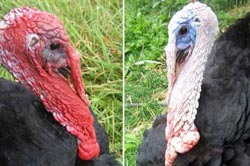Turkeys inspire smartphone-capable early warning system for toxins

Researchers took inspiration from the way turkey skin color is altered to create a new sensor that can change color when exposed to volatile chemicals.<br><br>Credit: Photos by Valerie Burtchett<br>
Turkey skin, it turns out, can shift from red to blue to white, thanks to bundles of collagen that are interspersed with a dense array of blood vessels. It is this color-shifting characteristic that gives turkeys the name “seven-faced birds” in Korean and Japanese.
The researchers say that spacing between the collagen fibers changes when the blood vessels swell or contract, depending upon whether the bird is excited or angry. The amount of swelling changes the way light waves are scattered and, in turn, alters the colors we see on the bird's head.
Seung-Wuk Lee, UC Berkeley associate professor of bioengineering, led a research team in mimicking this color-changing ability to create biosensors that can detect volatile chemicals.
“In our lab, we study how light is generated and changes in nature, and then we use what we learn to engineer novel devices,” said Lee, who is also a faculty scientist at the Lawrence Berkeley National Laboratory.
The researchers created a mobile app, called the iColour Analyser, to show that a smartphone photo of the sensor's color bands could be used to help identify toxins of interest. They described their experiments in a study to be published Tuesday, Jan. 21, in the journal Nature Communications.
Sensors that give off color readings are easier to use and read than conventional biosensors. However, the major ones in development elsewhere can only detect a limited range of chemicals and, according to the researchers, they can be very difficult to manufacture.
“Our system is convenient, and it is cheap to make,” said Lee. “We also showed that this technology can be adapted so that smartphones can help analyze the color fingerprint of the target chemical. In the future, we could potentially use this same technology to create a breath test to detect cancer and other diseases.”
In copying this turkey-skin design, Lee and his team employed a technique they pioneered to mimic nanostructures like collagen fibers. The researchers found a way to get M13 bacteriophages, benign viruses with a shape that closely resembles collagen fibers, to self-assemble into patterns that could be easily fine-tuned.
The researchers found that, like collagen fibers, these phage-bundled nanostructures expanded and contracted, resulting in color changes. The exact mechanism behind the shrinking or expanding phage bundles is still unclear, but it's possible that the small amount of water in the phage is reacting to the chemical vapors, the researchers said.
The turkey-inspired biosensors were exposed to a range of volatile organic compounds, including hexane, isopropyl alcohol and methanol, as well as vapor of the explosive chemical TNT, at concentrations of 300 parts per billion. The researchers found that the viruses swelled rapidly, resulting in specific color patterns that served as “fingerprints” to distinguish the different chemicals tested.
The researchers showed that the biosensor's specificity to a target chemical could be increased by genetically engineering the DNA in the M13 bacteriophage to bind with sites specific to TNT. The biosensor was then exposed to two additional chemicals, DNT and MNT, which have similar molecular structures to TNT. The engineered biosensor successfully distinguished TNT from the other chemicals with distinct color bands.
The biosensors were also able to signal changes in relative humidity, ranging from 20 percent to 90 percent, becoming redder with moister air and bluer with drier air.
The study lead author is Jin-Woo Oh, a former postdoctoral researcher in Lee's lab and now an assistant professor in the Department of Nanomaterial Engineering at Pusan National University in South Korea.
The National Science Foundation, the Defense Acquisition Program Administration and Agency for Defense Development in South Korea, Korea's Ministry of Education, Science and Technology, and Samsung helped support this work.
Media Contact
More Information:
http://www.berkeley.eduAll latest news from the category: Life Sciences and Chemistry
Articles and reports from the Life Sciences and chemistry area deal with applied and basic research into modern biology, chemistry and human medicine.
Valuable information can be found on a range of life sciences fields including bacteriology, biochemistry, bionics, bioinformatics, biophysics, biotechnology, genetics, geobotany, human biology, marine biology, microbiology, molecular biology, cellular biology, zoology, bioinorganic chemistry, microchemistry and environmental chemistry.
Newest articles

Silicon Carbide Innovation Alliance to drive industrial-scale semiconductor work
Known for its ability to withstand extreme environments and high voltages, silicon carbide (SiC) is a semiconducting material made up of silicon and carbon atoms arranged into crystals that is…

New SPECT/CT technique shows impressive biomarker identification
…offers increased access for prostate cancer patients. A novel SPECT/CT acquisition method can accurately detect radiopharmaceutical biodistribution in a convenient manner for prostate cancer patients, opening the door for more…

How 3D printers can give robots a soft touch
Soft skin coverings and touch sensors have emerged as a promising feature for robots that are both safer and more intuitive for human interaction, but they are expensive and difficult…





















